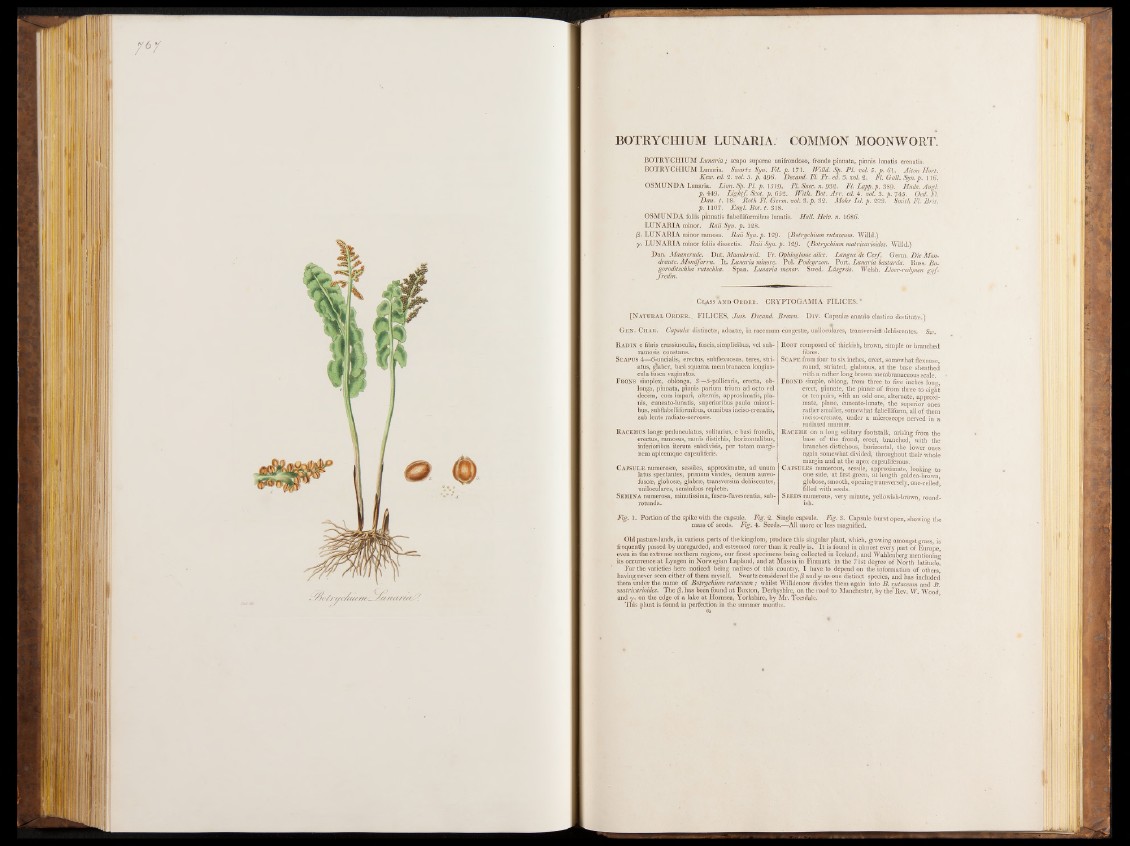
BOTRYCHIUM LUNARIA. COMMON MOONWORT.
BOTRYCHIUM' Lunaria; scapo superne unifrondoso, fronde pinnata, pinnis lunatis crenatis.
BOTRYCHIUM Lunaria. Swartz Syn. Fil. p . 171. Willd. Sp. PI. ml. 5. p. 61. Alton Hort.
Kew. ed. 2. ml. 5. p. 496. Decand. Fl. Fr. eel. 3. ml. 2. Fl. Gall. S yn .p . 1 1(5.
OSMUNDA Lunaria. Linn. Sp. PI. p. 1519. Fl. Suec. n. 932. Fl. Lapp. p. 389. Huds. Angl.
p . 449. Lig h tf. Scot. p. 652. With. Bot. A rr. ed. 4. ml. 3. p. 745. Oed. Fl.
Dan. t. 18. Roth Fl. Germ. ml. 3. p . 32. Mohr Isl. p. 223. Smith Fl. B rit,
p . 1107. Engl. Bot. t. 318.
OSMUNDA foliis pinnatis fläbelliformibus lunatis. Hall. Helv. n. 1686.
LUN A RIA minor. R aii Syn. p . 128.
ß . LUNARIA minor ramosa. R aii Syn. p. 129- (Botrychium rutaceum. Willd.)
y. LUN A RIA minor foliis dissectis. Raii Syn. p . 129- (Botrychium matricarioides. Willd.)
Dan. Maanerude. Dut. Maankruid. Fr. Ophioglosse ailee. Langue de Cerf. Germ. Die Mondraute.
Mondfarrn. It. Lunaria minore. Pol. Podeyrzon. Port. Lunaria bastarda. Russ. Bo-
goroditschka rutschka. Span. Lunaria menor. Swed. Lasgr'ds. Welsh. Lloer-redynen gyf-
fredin.
C lass and Order. CRYPTOGAMIA FIL ICE S. *
[N atural Order. . FILICES, Jus's. Decand. Brown. D iv . Capsulas annulo elastic© destitute.]
Gen . Char. Capsula distincte, adnate, in racemum congeste, uniloculares, transversirfr- debiscentes. Sw.
Radix e fibris crassiusculis, fuscis, simplicibus, vel sub-,
ramosis constans.
Scapus 4—6-uncialis, erectus, subflexuosus, teres, stri-
atus, glaber, basi squama membranacea longius-
eula fusca vaginatus.
Frons simplex, oblonga, 3—5-pollicaris, erecta, ob-
longa, pinnata, pinnis parium trium ad octo-vel
decern, cum impari, allernis, approximatis, plains,
cuneato-lunatis, superioribus paulo minori-
bus, subflabelliformibusj omnibus inciso-crenatis,
sub lente radiato-nervosis.
Racemus longe pedunculatus, solitarius, e basi frondis,
erectus, ramosus, ramis distichis, horizontal! bus,
inferioribus iterum subdivisis, per totam margi- '
nem apicemque capsuliferis.
Càpsuiæ numerosoe, sessiles, approximate, ad unum
latus spectantes, primum virides, demuni aureo-
fuscæ, globosæ, glabræ, transversim déhiscentes,
uniloculares, seminibus replete.
Semina numerosa, minutissima, fusco-flavescentia, subrotunda.
Root composed of thickish, brown, simple or branched
fibres.
Scape from four to six inches, erect, somewhat flexuose,
round, striated, glabrous, at the base sheathed
with a rather long brown membranaceous scale.
Frond simple, oblong, from three to five inches long,
erect, pinnate, the pinnre of from three to ei®ht
or ten pairs, with an odd one, alternate, approximate,
plane, cuneato-lunate, the superior ones
rather smaller, somewhat flabelliform, all of them
inciso-crenate, under a microscope nerved in a
radiated manner.
Raceme on a long solitary footstalk, arising from the
base of the frond, erect, branched, with the
branches distichous, horizontal, the lower ones
again somewhat divided, throughout their whole
margin and at the apex capsuliferous.
Capsules numerous, sessile, approximate, looking to
one side, at first green, at length golden-brown,
globose, smooth, opening transversely, one-celled
filled with seeds.
Seeds numerous, very minute, yellowish-brown, roundish.
Fig. 1. Portion of the spike with the capsule. Fig. 2. Single capsule. Fig. 3. Capsule burst open, showing the
mass of seeds. Fig. 4. Seeds.—All more or less magnified.
Old pasture-lands, in various parts o f the kingdom, produce this singular plant, which, growing amongst grass, is
frequently passed by unregarded, and esteemed rarer than it really is. I t is found in almost every p art of Europe,
even in the extreme northern regions, our finest specimens being collected in Iceland, and Wahlenber» mentioning
its occurrence a t Lyngen in Norwegian Lapland, and at Massia in Finmark in the 71st degree of North latitude!
For the varieties here noticed being natives of this country, I have to depend on the information of others
having never seen either o f them myself. Swartz considered the (3 and y as one distinct species, and has included
them under the name of Botrychium rutaceum ; whilst Willdenow divides them again into B. rutaceum and B.
matricarioides. The /S. has been found a t Buxton, Derbyshire, on the road to Manchester, by the* Rev. W. Wood
and y. on the edge of a lake at Hornsea, Yorkshire, by Mr. Teesdalc.
This plant is found in perfection in the summer months.